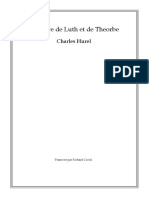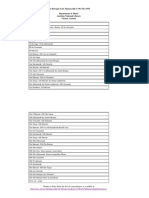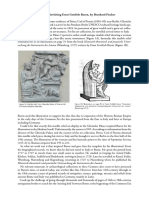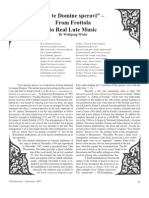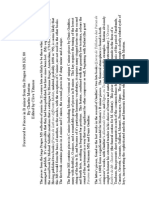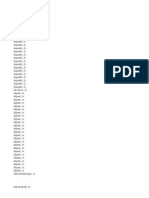Bernhard Joachim Hagen
Bernhard Joachim Hagen
Uploaded by
Diana GhiusCopyright:
Available Formats
Bernhard Joachim Hagen
Bernhard Joachim Hagen
Uploaded by
Diana GhiusOriginal Description:
Copyright
Available Formats
Share this document
Did you find this document useful?
Is this content inappropriate?
Copyright:
Available Formats
Bernhard Joachim Hagen
Bernhard Joachim Hagen
Uploaded by
Diana GhiusCopyright:
Available Formats
Bernhard Joachim Hagen - Wikipedia, the free encyclopedia
1 of 3
https://en.wikipedia.org/wiki/Bernhard_Joachim_Hagen
Bernhard Joachim Hagen
From Wikipedia, the free encyclopedia
Bernhard Joachim Hagen (April 1720 in or near Hamburg (?) December 9, 1787 in Ansbach)
was a German composer, lutenist and violinist. He was the last important composer of lute music in
18th-century Germany.
Contents
1
2
3
4
Life
Works
Influence
Literature & Sources
Life
Little is known about his youth, but he obviously grew up in a musical family: his brother Peter
Albrecht Hagen (also called Peter Albert van Hagen, 1714 - September 12, 1777) studied the
violin with Francesco Geminiani, learned to play the lute and organ, and was an organist in
Rotterdam. There are several transcriptions of Geminiani's violin works for lute by J.B. Hagen
extant.
The younger Bernhard Joachim Hagen must have learned to play lute and violin early too, for in
1737 he was already employed as an assistant to Bayreuth violin virtuoso and Kapellmeister Johann
Pfeiffer; later he was listed officially as a court violinist. He kept this position at the Bayreuth and
since 1769 the Ansbach court until his death. Adam Falckenhagen and Charles Durant (Carol
Duranowski), also called to the Bayreuth court by Wilhelmine of Bayreuth, may have further
trained him in playing the lute.
In 1745, Hagen married Anna Fikentscher (born in Bayreuth; died May 22, 1789 in Ansbach).
During 1760/1761 he visited his brother in Rotterdam and there gave five concerts from November
till March.
Works
Hagen was employed at the Bayreuth court as a violinist and as a lutenist, and his virtuoso lute
performances and his compositions for lute were known and appreciated. He is one of the most
important composers for lute in the era following Sylvius Leopold Weiss, and far more important
than his teachers Falckenhagen and Durant. His style is shaped by the Empfindsamkeit and the
10/4/2016 4:50 PM
Bernhard Joachim Hagen - Wikipedia, the free encyclopedia
2 of 3
https://en.wikipedia.org/wiki/Bernhard_Joachim_Hagen
beginning of the Sturm und Drang period. There is a clearly discernible influence of Carl Philipp
Emmanuel Bach in Hagen's music.
Through margravine Wilhelmine's efforts, lute music flourished in the 18th century one last time
before being rediscovered in the 20th century.
There are 33 known compositions by Bernhard Joachim Hagen found in the Staats- und
Stadtbibliothek Augsburg:
12 Sonatas for Lute solo
6 Trios for Lute, Violin and Violoncello
2 Lute concerti
1 Duo for two Lutes
1 Duo for Lute und Violin
Many Lute arrangements of compositions by Geminiani, Locatelli, Arne, and others.
The facsimile editions of Hagen's solo lute sonatas (1983) and chamber works (1984) have been
published by Joachim Domning for the Roman Trekel Musikverlag.
There are two excellent CD recording of Hagen's sonatas by the lutenist Robert Barto:
Joachim Bernhard Hagen, Solo Works for Lute: Five Sonatas, Locatelli Variations (Naxos
8.554200)
Bernhard Joachim Hagen, Sonate Liuto solo (Symphonia Sy98164)
Some of Hagen's works listed in the 1769 Breitkopf catalog (these have no concordances in
Augsburg manuscripts) are presumed missing.
Influence
The lute sonatas of Roman Turovsky-Savchuk (a contemporary lutenist-composer) were written in
homage to Hagen.
Literature & Sources
Ernst Ludwig Gerber: Historisch-biographisches Lexicon der Tonknstler, Teil 1. (1790)
Rainer Trbsbach: Geschichte der Stadt Bayreuth. Druckhaus Bayreuth (1993)
Robert Barto: Bernhard Joachim Hagen, Sonate Liuto solo CD Booklet (1999)
Per Kjetil Farstad: Bernhard Joachim Hagen (1720-87): Some New Biographical Information,
in: The Lute. Journal of the Lute Society, Vol. 40 (2000), p. 1-11.
Retrieved from "https://en.wikipedia.org/w/index.php?title=Bernhard_Joachim_Hagen&
10/4/2016 4:50 PM
Bernhard Joachim Hagen - Wikipedia, the free encyclopedia
3 of 3
https://en.wikipedia.org/wiki/Bernhard_Joachim_Hagen
oldid=708981879"
Categories: 1720 births 1787 deaths German composers Composers for lute
German lutenists 18th-century composers
This page was last modified on 8 March 2016, at 14:56.
Text is available under the Creative Commons Attribution-ShareAlike License; additional
terms may apply. By using this site, you agree to the Terms of Use and Privacy Policy.
Wikipedia is a registered trademark of the Wikimedia Foundation, Inc., a non-profit
organization.
10/4/2016 4:50 PM
You might also like
- Nigel North Continuo Lute Arch Theorbo PDFDocument306 pagesNigel North Continuo Lute Arch Theorbo PDFJosé Villamayor86% (7)
- Sylvius Leopold Weiss Lute Duets. With A Reconstructed Second Part.Document9 pagesSylvius Leopold Weiss Lute Duets. With A Reconstructed Second Part.Edy Koysi100% (1)
- Lute Quartets (Vallet)Document30 pagesLute Quartets (Vallet)Tim BeattieNo ratings yet
- Osborn Fb7Document9 pagesOsborn Fb7Johann Mauer100% (1)
- TheorboDocument0 pagesTheorbousuarioluiscarlosNo ratings yet
- "Chitarrone, Theorbo and Archlute - Robert Spencer - (Early Music Journal, October 1976)Document15 pages"Chitarrone, Theorbo and Archlute - Robert Spencer - (Early Music Journal, October 1976)hakrekNo ratings yet
- GB-RMathew The Lutes Apology (1652)Document49 pagesGB-RMathew The Lutes Apology (1652)Ivan Jellinek100% (2)
- A-Kremsmünster L78Document93 pagesA-Kremsmünster L78Ivan Jellinek100% (1)
- B-BR Ms II 4086 DurantDocument89 pagesB-BR Ms II 4086 DurantIvan Jellinek100% (2)
- German Lute Concertos of The Galant Era From B-BR MS II 4089Document218 pagesGerman Lute Concertos of The Galant Era From B-BR MS II 4089Ivan Jellinek100% (3)
- Hurel PDFDocument30 pagesHurel PDFtiorba100% (1)
- Beethoven PastoralDocument28 pagesBeethoven PastoralJordi CosNo ratings yet
- A-Wn MusHs 18760 The Baroque Lute Manuscript "Harmonia Quadripartita" by Johann Theodor Herold, 1702)Document31 pagesA-Wn MusHs 18760 The Baroque Lute Manuscript "Harmonia Quadripartita" by Johann Theodor Herold, 1702)ViennaluteNo ratings yet
- A-Wn MusHs 1078 Baroque Lute Manuscript From Vienna Ms 1078Document86 pagesA-Wn MusHs 1078 Baroque Lute Manuscript From Vienna Ms 1078Viennalute100% (3)
- Tim Crawford: Editing Weiss For Thesämtliche Werke: The Composer'S Contribution To The London and Dresden ManuscriptsDocument12 pagesTim Crawford: Editing Weiss For Thesämtliche Werke: The Composer'S Contribution To The London and Dresden ManuscriptsjaiversonNo ratings yet
- PL-KJ 40633 Radke (1753)Document46 pagesPL-KJ 40633 Radke (1753)Ivan JellinekNo ratings yet
- Cittern BookDocument16 pagesCittern BookTio JorgeNo ratings yet
- Weiss CatDocument63 pagesWeiss CatJelenaStojiljkovicVranesevicNo ratings yet
- A-Wn MusHs 1078 Copperplate Engravings From The Baroque Lute Manuscript A-Wn 1078Document10 pagesA-Wn MusHs 1078 Copperplate Engravings From The Baroque Lute Manuscript A-Wn 1078ViennaluteNo ratings yet
- Italian Lute Duets PDFDocument98 pagesItalian Lute Duets PDFSandro Volta100% (1)
- D-Burkhard Korn - Bach BWV 1xxx Baroque LuteDocument208 pagesD-Burkhard Korn - Bach BWV 1xxx Baroque LuteIvan Jellinek100% (2)
- PL-WRu 2002Document95 pagesPL-WRu 2002Ivan Jellinek100% (1)
- US-NYPL Harrach 14Document50 pagesUS-NYPL Harrach 14Ivan Jellinek100% (1)
- Theorbo SizesDocument4 pagesTheorbo SizesBalaji DasaNo ratings yet
- US-Lute Chorales GDBeckman THESISDocument258 pagesUS-Lute Chorales GDBeckman THESISIvan JellinekNo ratings yet
- Mathew Holmes Lute BooksDocument12 pagesMathew Holmes Lute BooksPeyman KeramatfarNo ratings yet
- Rebuilding The 1699 Andreas Berr LuteDocument4 pagesRebuilding The 1699 Andreas Berr LuteViennaluteNo ratings yet
- F-Pieces de Luth Livre 2 Charles MoutonDocument65 pagesF-Pieces de Luth Livre 2 Charles MoutonIvan Jellinek0% (1)
- Herbert MynshallDocument48 pagesHerbert MynshallsemperdowlandNo ratings yet
- The Lute Instructions of Jean Baptiste Besard PDFDocument19 pagesThe Lute Instructions of Jean Baptiste Besard PDFLelio Colista100% (1)
- Kalmar 21068Document51 pagesKalmar 21068mark5009100% (1)
- STRAUBE, Rudolfo - Due Sonate A Liuto Solo (Leipzig, 1746) (Facsimile Lute Tablature)Document17 pagesSTRAUBE, Rudolfo - Due Sonate A Liuto Solo (Leipzig, 1746) (Facsimile Lute Tablature)Gérard Reyne100% (1)
- Adrian Le RoyDocument3 pagesAdrian Le RoyIgnacio Juan GassmannNo ratings yet
- Lute and Organ Tablatures From The 15th To 17th CenturyDocument3 pagesLute and Organ Tablatures From The 15th To 17th CenturyFang-Yi ChuNo ratings yet
- Bellerofonte Castaldi of Modena: Musician, Poet, and AdventurerDocument28 pagesBellerofonte Castaldi of Modena: Musician, Poet, and AdventureramadeushendrixNo ratings yet
- The History of The Lute: Revisiting Ernst Gottlieb BaronDocument4 pagesThe History of The Lute: Revisiting Ernst Gottlieb BaronViennaluteNo ratings yet
- Tree Edition Catalogue February 2017 - DecryptedDocument34 pagesTree Edition Catalogue February 2017 - DecryptedtiorbaNo ratings yet
- Pieces de Luth Jacques GallotDocument76 pagesPieces de Luth Jacques GallotJonas JehanderNo ratings yet
- A-Wgm MS 3102 SCH Mandora School Tabulature ViennaDocument5 pagesA-Wgm MS 3102 SCH Mandora School Tabulature ViennaViennaluteNo ratings yet
- PL-KJ 40625Document58 pagesPL-KJ 40625Ivan JellinekNo ratings yet
- Goess ManuscriptDocument2 pagesGoess Manuscriptlemon-kun100% (1)
- Chitarrone FranceseDocument4 pagesChitarrone FranceseFrancesco Maria Mazzolini100% (1)
- D-Bach BWV 999Document3 pagesD-Bach BWV 999Ivan JellinekNo ratings yet
- A-Wn MusHs 18826 The Baroque Lute Manuscript of Johann Gotthard Peyer. Vienna, 1672Document9 pagesA-Wn MusHs 18826 The Baroque Lute Manuscript of Johann Gotthard Peyer. Vienna, 1672ViennaluteNo ratings yet
- B.W. Thomas Thesis - The Lute Books of BarbettaDocument260 pagesB.W. Thomas Thesis - The Lute Books of BarbettaAndre Nieuwlaat100% (1)
- D-Mbs Mus. Ms. 21646 Albrecht Wörl (1627 - 1650)Document98 pagesD-Mbs Mus. Ms. 21646 Albrecht Wörl (1627 - 1650)Ivan Jellinek100% (2)
- GB-TCrawford SLWeiss Mss London and Dresden LINKDocument1 pageGB-TCrawford SLWeiss Mss London and Dresden LINKIvan JellinekNo ratings yet
- Simon Gintzler: Intabolatura de LautoDocument62 pagesSimon Gintzler: Intabolatura de Lautolemon-kun100% (1)
- "In Te Domine Speravi" - From Frottola To Real Lute MusicDocument7 pages"In Te Domine Speravi" - From Frottola To Real Lute Musicapi-3862478100% (2)
- Mouton ForewordDocument2 pagesMouton ForewordFhomensNo ratings yet
- The Andreas Berr Lute From 1699Document5 pagesThe Andreas Berr Lute From 1699ViennaluteNo ratings yet
- GB-En Ms. 9451 - Panmure 4Document38 pagesGB-En Ms. 9451 - Panmure 4Ivan Jellinek100% (4)
- Booklet CHR77355Document29 pagesBooklet CHR77355PuntoNo ratings yet
- D-Burkhard Korn - Bach BWV 8xx Baroque LuteDocument106 pagesD-Burkhard Korn - Bach BWV 8xx Baroque LuteIvan JellinekNo ratings yet
- On The Origin of The ChitarroneDocument24 pagesOn The Origin of The ChitarroneJavier Ovejero Mayoral100% (2)
- Bach X FluteDocument15 pagesBach X FluteregalizNo ratings yet
- Johann Sebastian BachDocument21 pagesJohann Sebastian BachEdward MirandaNo ratings yet
- BachDocument2 pagesBachTriumphant MichaelNo ratings yet
- Bach Concerto BWV 1060 1112Document3 pagesBach Concerto BWV 1060 1112TimNo ratings yet
- Trust (Emotion) - WikipediaDocument12 pagesTrust (Emotion) - WikipediaDiana GhiusNo ratings yet
- Western Culture - WikipediaDocument30 pagesWestern Culture - WikipediaDiana GhiusNo ratings yet
- Tao Te Ching - WikipediaDocument12 pagesTao Te Ching - WikipediaDiana GhiusNo ratings yet
- Self Interest WikipediaDocument2 pagesSelf Interest WikipediaDiana GhiusNo ratings yet
- Thought - WikipediaDocument9 pagesThought - WikipediaDiana GhiusNo ratings yet
- Søren Kierkegaard - WikipediaDocument63 pagesSøren Kierkegaard - WikipediaDiana GhiusNo ratings yet
- Temperance (Virtue) - WikipediaDocument5 pagesTemperance (Virtue) - WikipediaDiana Ghius100% (1)
- Subjective Well-Being - WikipediaDocument13 pagesSubjective Well-Being - WikipediaDiana GhiusNo ratings yet
- Sorrow (Emotion) - WikipediaDocument3 pagesSorrow (Emotion) - WikipediaDiana GhiusNo ratings yet
- Shame - WikipediaDocument9 pagesShame - WikipediaDiana GhiusNo ratings yet
- Self Confidence WikipediaDocument14 pagesSelf Confidence WikipediaDiana GhiusNo ratings yet
- Saudade - WikipediaDocument8 pagesSaudade - WikipediaDiana GhiusNo ratings yet
- Schadenfreude - WikipediaDocument39 pagesSchadenfreude - WikipediaDiana GhiusNo ratings yet
- Resentment - WikipediaDocument5 pagesResentment - WikipediaDiana GhiusNo ratings yet
- Scientific Method - WikipediaDocument38 pagesScientific Method - WikipediaDiana GhiusNo ratings yet
- Regret - WikipediaDocument5 pagesRegret - WikipediaDiana GhiusNo ratings yet
- Pity - WikipediaDocument4 pagesPity - WikipediaDiana GhiusNo ratings yet
- Pragmatism - WikipediaDocument29 pagesPragmatism - WikipediaDiana GhiusNo ratings yet
- Psychomotor Agitation - WikipediaDocument3 pagesPsychomotor Agitation - WikipediaDiana GhiusNo ratings yet
- Sadness - WikipediaDocument5 pagesSadness - WikipediaDiana GhiusNo ratings yet
- Remorse - WikipediaDocument6 pagesRemorse - WikipediaDiana GhiusNo ratings yet
- Pleasure - WikipediaDocument7 pagesPleasure - WikipediaDiana GhiusNo ratings yet
- Passion (Emotion) - WikipediaDocument8 pagesPassion (Emotion) - WikipediaDiana GhiusNo ratings yet
- Ontology - WikipediaDocument13 pagesOntology - WikipediaDiana GhiusNo ratings yet
- Narcissism - WikipediaDocument22 pagesNarcissism - WikipediaDiana GhiusNo ratings yet
- Metaphysics - WikipediaDocument23 pagesMetaphysics - WikipediaDiana GhiusNo ratings yet
- Observational Study - WikipediaDocument4 pagesObservational Study - WikipediaDiana GhiusNo ratings yet
- Modesty - WikipediaDocument16 pagesModesty - WikipediaDiana GhiusNo ratings yet
- Sammlung BoijeDocument93 pagesSammlung Boijeapi-3704214No ratings yet
- Viennese Stringed-Instrument Makers 1700-1800Document26 pagesViennese Stringed-Instrument Makers 1700-1800rod1988No ratings yet
- Oppgave Marina PopovicDocument75 pagesOppgave Marina PopovicAnneNo ratings yet
- A Short Analysis of Segoviana by D. MilhaudDocument5 pagesA Short Analysis of Segoviana by D. Milhaudbouklis100% (1)
- Dane Suarez - RésuméDocument1 pageDane Suarez - RésuméDane SuarezNo ratings yet
- Assessment Unit A2 3: Part 2 Written Examination: MusicDocument4 pagesAssessment Unit A2 3: Part 2 Written Examination: MusicJohnny WattNo ratings yet
- Pachelbels Canon in D Major - Concert Band-MarimbaDocument2 pagesPachelbels Canon in D Major - Concert Band-MarimbaMery FloresNo ratings yet
- Symphony No.40Document3 pagesSymphony No.40Johnny Watt50% (2)
- Home Stories News: Pepe RomeroDocument7 pagesHome Stories News: Pepe RomerocarloshwalterNo ratings yet
- Shostakovich Sympony No. 9Document4 pagesShostakovich Sympony No. 9Ray ChanNo ratings yet
- Sandy Lake ListDocument3 pagesSandy Lake Listapi-253584666No ratings yet
- Mozart Sonata No16 in Cmajor k545Document14 pagesMozart Sonata No16 in Cmajor k545GourabNo ratings yet
- Personal Statement LukaDocument2 pagesPersonal Statement LukaLukaPerazicNo ratings yet
- CMPDocument2 pagesCMPapi-273394578No ratings yet
- Tui Amoris IgnemDocument4 pagesTui Amoris IgnemSalvatore LambertiNo ratings yet
- Весільний маршDocument9 pagesВесільний маршdl escNo ratings yet
- History of The Classical Period of MusicDocument18 pagesHistory of The Classical Period of MusicLhoy Guisihan Asoy IdulsaNo ratings yet
- Basic Music Concert Proposal 2Document4 pagesBasic Music Concert Proposal 2José Ortiz CharriezNo ratings yet
- Cello Partiture in G Major Part 2Document1 pageCello Partiture in G Major Part 2Jorgeluis SanchezNo ratings yet
- Analysis Worksheet ElegyDocument5 pagesAnalysis Worksheet ElegyRenzo Ramos MogollónNo ratings yet
- The Late Liszt v4Document7 pagesThe Late Liszt v4TamásZétényiNo ratings yet
- Gubaidulina - List of WorksDocument7 pagesGubaidulina - List of WorksOsvaldo SuarezNo ratings yet
- Roll Off - Score and PartsDocument45 pagesRoll Off - Score and PartsManuelsilvasaxNo ratings yet
- (Free Scores - Com) - Bach Johann Sebastian French Suite G Major Sarabande 214 PDFDocument2 pages(Free Scores - Com) - Bach Johann Sebastian French Suite G Major Sarabande 214 PDFGripenNo ratings yet
- Betoven SonataDocument13 pagesBetoven SonataTanja M. RistićNo ratings yet
- Nimrod - ScoreDocument6 pagesNimrod - ScoreMonica van der VeldeNo ratings yet
- Piano Method 401: Composer: D. Scarlatti (1685 - 1757)Document13 pagesPiano Method 401: Composer: D. Scarlatti (1685 - 1757)lyndi beyersNo ratings yet
- Olas Del DanubioDocument13 pagesOlas Del DanubioJoás ErateNo ratings yet










